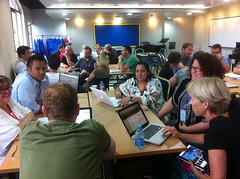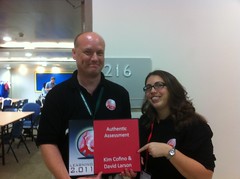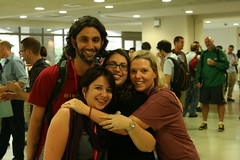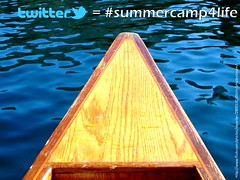It’s hard to believe another Learning 2.0 conference has come and gone. Yet again, the organizers created an innovative and engaging learning environment. It’s fantastic to watch how this conference has evolved from year to year, and just continues to get better and better. Personally, I thought this year was the best yet. Here’s why:
Cohorts of Learners
This is the second year in a row that Learning 2.0 has followed a cohort model for part of the conference. I love the idea of spending a set chunk of time with a set group of participants. To me, this adds another layer of learning, connections, and conversations to an already very learner-focused event.
 Last year the conference was organized so that we had just cohort time and unconference time, which was a little tricky. I felt, as a cohort leader, that I was responsible for teaching all the things that participants could have possibly learned in a presentation session, and I think the participants felt a bit like they didn’t really know what to do with the unconference time. This year, the amount of time in cohorts was reduced, and additional presentation time was added, for a fabulous trifecta of cohorts, presentations and unconference time. It’s so important to keep that presentation time – not only does it encourage other participants to present, but it showcases the amazing things that are going on in schools all around Asia. I think this year was a perfect balance of all three formats.
Last year the conference was organized so that we had just cohort time and unconference time, which was a little tricky. I felt, as a cohort leader, that I was responsible for teaching all the things that participants could have possibly learned in a presentation session, and I think the participants felt a bit like they didn’t really know what to do with the unconference time. This year, the amount of time in cohorts was reduced, and additional presentation time was added, for a fabulous trifecta of cohorts, presentations and unconference time. It’s so important to keep that presentation time – not only does it encourage other participants to present, but it showcases the amazing things that are going on in schools all around Asia. I think this year was a perfect balance of all three formats.
 The cohort concept is also fantastic because it provides a lens through which the participants can view the conference. This gives a focus to what participants are learning and allows dedicated time to discuss and reflect on everything they’ve seen. This year I was asked to lead a cohort called Authentic Assessment and Digital Media. Thankfully, I (once again) had a superstar partner, David Larson (last year I had the privilege of working with Darren Kurropatwa), because it was a challenging topic to facilitate. For starters, I read the title and thought: “Fun! Project Based Learning and Multimedia! We can share ways that we’re transforming our classroom to bring in the design process and authentic student-led projects!” But, on the first evening, when I asked participants what they were looking for, they said things like:
The cohort concept is also fantastic because it provides a lens through which the participants can view the conference. This gives a focus to what participants are learning and allows dedicated time to discuss and reflect on everything they’ve seen. This year I was asked to lead a cohort called Authentic Assessment and Digital Media. Thankfully, I (once again) had a superstar partner, David Larson (last year I had the privilege of working with Darren Kurropatwa), because it was a challenging topic to facilitate. For starters, I read the title and thought: “Fun! Project Based Learning and Multimedia! We can share ways that we’re transforming our classroom to bring in the design process and authentic student-led projects!” But, on the first evening, when I asked participants what they were looking for, they said things like:
- Strategies for formative assessment
- Revising rubrics
- How to ensure that technology skills are being mapped and assessed
- How to assess technology standards
- How to map technology standards
Of course, all of these things are very important, but it wasn’t quite the vision I had for the cohort – especially given the fact that there were 50 people from at least 40 different schools, all at different places and with different standards and expectations. So, we did our best to share our ideas, allow others to share theirs, and to provide time to work together to answer some of the questions the brought with them to the conference. I think (hope) they walked away with something useful, and I certainly learned a lot.
A few highlights for me were:
- We need time to re-frame what we’re talking about. Why are we doing the things we’re doing? Finding a few really great articles and allowing time for participants to read, and then jigsaw back to a new group where everyone read a different article is a very effective way to do this.
- It was clear that participants really wanted (and needed) time to share what they are doing in their schools, challenges they face, and solutions or opportunities they could take advantage of (we did a SpeedGeeking session and a department-focused session to facilitate this)
- Formative assessment is a big challenge for teachers – we need some quick and easy strategies that teachers can implement, especially in a 1:1 environment (lots of good ideas about this for another post)
- The MYP Design Cycle (or any kind of design process) really does fit for any subject, but it takes time and teachers need help understanding that a technology-rich project that’s done thoroughly usually means more time, rather than less (we need to stop saying “make a movie about this for homework”).
- Almost every participant in the cohort was either in a 1:1 school, or their school was moving in that direction. Most had heard of the ISTE NETS standards and were applying them in some form at their school. Everyone had a positive story to share about the use of technology in their school – although they were all at very different levels.
- People still like to watch presentations. Some of the feedback from our session was that David and I didn’t do any formal presenting. I thought that was a good thing, but clearly I need to find a way to strike a balance between teaching directly (while modeling good presentation skills), and facilitating discussion.
- I need to remember to always, always, always highlight student work. I tend to get caught up in the abstract and big ideas, but teachers really appreciate concrete examples. In retrospect, I could have easily brought out student samples of work, rubrics I’ve used, and unit planners I’ve created and we could have deconstructed them (it’s not like I didn’t have them with me!). Then participants could have done the same with student work from their schools. It is so obvious, yet somehow I missed it. (Now I want to run the same topic again and do it better!)
- How to walk the fine line between focusing on tools and why we use the tools. Teachers seem to like being “wowed” with so many tools they couldn’t possibly absorb them all, but often are reluctant to talk about the bigger concepts of a changing classroom environment, or a media-rich world, or critical skills for the future, because those topics aren’t “practical”. I do believe teachers need to know what tools are out there, but I think knowing what they want to do with the technology and why they want to do it is so much more important. To me, just demoing a bunch of tools feels like eating too much candy, fun and sweet and exciting at the start, but after a while you get a stomach ache. Where’s the nutrition?
I love that feeling when you get to meet people you’ve been learning with for years online, in person. It’s amazing that you can kind of “skip to the good stuff” right away because you already know each other from so many different forms of communication. This conference has to be my absolute favorite for those kinds of connections. Walking into our cohort leaders planning session and seeing Wes Fryer, Rod Lucier, Darren Kurropatwa, George Couros, Alec Couros, Jess McCulloch, Kevin Honeycutt, Anne Mirstchin, Jeff Utecht, Julie Lindsay, Ann Krembs, Jabiz Raisdana, Jarrod Robinson, Toni Erni, Gail Lovely, Charlotte Diller, Sheldon Bradshaw, Michael Boll, and the amazing conference organizing team, is quite the buzz.
What’s even better is that when we did our mini-keynotes, all of our ideas built upon one another – and there was no collaborative planning for these presentations, no discussion of what we would do before we got on stage. We’re all thinking about the same things, and when we get together, we can get right down to talking about “doing bigger stuff” (as Jess likes to say). And on top of all that, getting the chance to see the wonderful people that are such an integral part of my personal learning network all together in the same place just can’t be beat! These connections are what it’s all about.
Momentum

It is amazing to come back year after year to this conference and see how teachers and schools are moving forward. Seeing former participants come back as unconference leaders, former unconference leaders come back as presenters, and former presenters come back as cohort leaders is fantastic! This conference has become a community of learners that connects and reconnects in many ways, and we’re all continually pushing ourselves and our schools forward. I love working in Asia because of this feeling of momentum we have, it’s contagious and it spreads from school to school as our teachers move around and share their learning.
I like to tease my good friend Jabiz about being my first protégé (sorry BZ), but all I did was give him a ball (in this case the ball was WordPress instead of Dreamweaver) and he ran with it. Same goes for Dana Watts (formerly at ISB), and Rebekah Madrid and Zoe Page (here at YIS). We had a few conversations here and there, and before I knew it, they were running with that ball so fast, doing new things in inspiring ways. It’s such a pleasure to come to a conference like this and see all of them together, knowing that there are groups of people all over the venue with the same kinds of stories and connections. We’re all moving forward together.
 I’m especially proud to have brought a team of teachers from YIS to the conference this year too. Having a group of us at the conference, spending time thinking about these big ideas together, and then being able to share them back at school, is just one of the many ways the momentum continues to spread. Thanks for coming Zoe, Rebekah , Elif, Brian and Trevor! Looking forward to bringing this energy and enthusiasm back to YIS throughout the year.
I’m especially proud to have brought a team of teachers from YIS to the conference this year too. Having a group of us at the conference, spending time thinking about these big ideas together, and then being able to share them back at school, is just one of the many ways the momentum continues to spread. Thanks for coming Zoe, Rebekah , Elif, Brian and Trevor! Looking forward to bringing this energy and enthusiasm back to YIS throughout the year.
Final Thoughts
Thanks Learning 2.011 team for inviting me back another year. It’s truly an honor to be part of the community that you have created. I’m already looking forward to Learning 2.012!
Image Credits
- Group Project Time by superkimbo on Flickr
- Authentic Assessment by superkimbo on Flickr
- #summercamp4life by Clint Hamada on Flickr
- Kim and the Protégés by Clint Hamada on Flickr
- YIS Crew 4 by Clint Hamada on Flickr






Great reflection, Kim! I agree this year was the best ever! Lots of reasons (people mainly) but the schedule WAS superb. I love the chance to learn & share at this conference! I feel like I walk away with far more than I gave away. Working and teaching with a co-facilitator is so invigorating! Best way to teach, IMHO. :-)
@Wes, So true! I have learned so much every year! Love being able to collaborate with someone else to lead the cohorts too – everything is so much better when there are two of you!
Thanks for all the shout outs Kim! There is something special about seeing a photo that you took used in somebody else’s work. It makes me want to take and share even more!
I think the greatest thing about Learning 2.0 as a conference is the fact that it is constantly evolving. Learning 2.008 was pushing the boundaries with Twitter and backchannels; Learning 2.010 brought the cohort and unconference model; Learning 2.011 took a great idea and made it better with more scheduled presentations. I’m excited to see what Learning 2.012 will bring us!
I cannot agree more with the point you raised about technology-rich projects taking more time. Despite all of our best intentions, this never seems to be adequately planned for. It also raises a bigger question in my mind: If all of this awesome real-world stuff is important and necessary (and I absolutely believe that it is!) and we know that it takes more time, what do we take out to compensate? Otherwise, it is just subtraction by addition…
Clint Hamada´s last blog post ..Capacity, Connections and Camp
@Clint,
Yes, the question of what to take out is so important. I think it’s hard for teachers to “give up” any of their content, but when we get down to the actual ability for students to deeply interact with the content, in an appropriate context, while creating something meaningful, something has to give.
At ISB we tried something simple, and to be honest, I’m not totally sure how effective it was because I left at the end of that school year, but I like the idea. Teachers were asked to determine exactly what students needed to know to be successful at their course, ie: to outline what needed to be taught in the year before. The goal was to enable all teachers to look at their course through a student’s perspective, and to give teachers some freedom to “let things go”. As long as teachers were being realistic in their expectations for students entering their course, it could be a good model. What do you think?
This sounds really amazing – wish I was there. I particularly loved your reflections on being a cohort leader; how much time was devoted to it? How did the unconference go?
Malyn´s last blog post ..Circles, Spaces and Ripples
@Malyn,
How much time for the cohorts? We had 45 mins on the first night, then a little over 4 hours (in 4 separate blocks) throughout the conference. Unconferences are always great in my opinion – a great way for participants to stick a toe into the idea of presenting or facilitating, or for people to just make sense of what they’re learning, or some down time to process on their own.
I am a student in EDM310 at the University of South Alabama. I am in the college of education, studying to get my elementary education degree. I read your blog post today and I feel very intrigued. There is still quite a bit that I need to learn, in the way of standards, terminology, and much of the technology now being used. I have learned a great deal of valuable information when it comes to finding and using resources on the internet.
I enjoyed reading your post and aim to learn a lot from it. I am one of those people that agrees with the “hands on” experience. I really get into a lesson or speech, when I can see something concrete to learn from. Many children need that kind of stimulation to intrigue their minds and imagination. I work well in any situation, whether it is just listening or seeing something for myself. I like how you explained in great detail about all the aspects of the conference. It will even be a great resource for perspective teachers as well as educators now. I look forward to being able to attend conferences to help me with my teaching and instruction in my very own classroom!
@Deena,
Thanks!
Kim,
What I like and learn from your reflections is you think of the big ideas and the small details. You write honesty and directly which adds perspective to your posts. I absolutely loved that you used LiveStream. I saw the mention on twitter and used the link to be a “fly on the wall.” It was crazy because it was happening live. It gave meaning and purpose to my learning. Jabiz Raisdana said recently, “Open Yourself Up” and you do that so well. Thank you!
@Cathy,
Thanks for joining us in the LiveStream! That was actually the following weekend after Learning 2.011 for a workshop Chris Betcher and I ran at my school, YIS. (Back-to-back workshops for me!).
So glad you got something out of the experience – wish I had been able to include someone on the moderation side for the LiveStream to really feed in what our virtual participants were talking about. Next time!
Fantastic news to learn how much you are doing to teach teachers how to zoom into the 21st century…and all around the world.
@Robin,
Thanks!
Your blog post was very insightful and offered many good ideas about what can be done with education. I particularly agree that educators should focus on the fine line between presenting tools and teaching how to actually be productive with them. In some of my graphic design and cinematography classes in high school, the instructors would cover various programs, such as Photoshop, Adobe Illustrator, Dreamweaver, Final Cut Pro, etc., but we’d only have a week or so to go over the material, at which point the class would generally rely on only one of the programs for the rest of the year. As such, we never received a true education in most of the programs and the time could have been better spent simply focusing on one of them all along. If schools have to pick what to cut to flesh out their technological courses, I believe that the least they could do is abandon their quantity over quality mentality and just focus on one program. That way, students will excel with at least one tool rather than none.